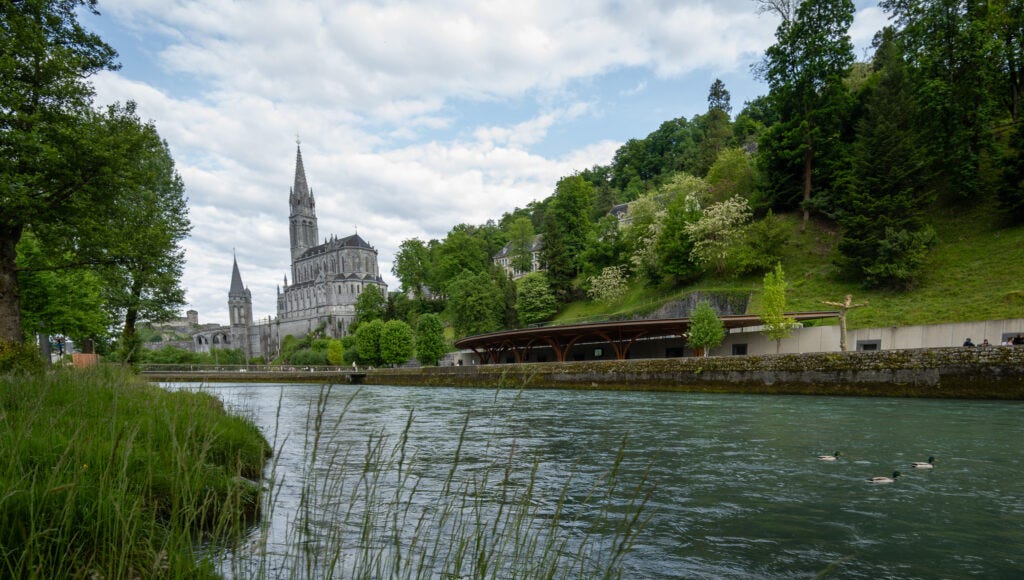Helping Heal the Invisible Wounds of War
How the Warriors to Lourdes pilgrimage gives U.S. military personnel a chance to find peace.
*This article was originally published by Philanthropy Daily
War inflicts harsh physical and emotional wounds. Yet, for some combat veterans, the wounds pierce deeper, even severing one from God. Healing, then, cannot be simply treated by doctors or remedied by therapy—but requires a specialized treatment for the soul.
Warriors to Lourdes, sponsored by the Archdiocese of Military Services-USA (AMS) and the Knights of Columbus (KofC), is one such treatment. Through the program, veterans and active-duty military personnel have the opportunity to find healing from the visible and invisible wounds of war, bridging a spiritual chasm between themselves, their fellow man, and the Almighty.
Coinciding with the annual Pèlerinage Militaire International (PMI)—the International Military Pilgrimage—more than 14,000 troops from 40 nations meet in Lourdes, France, each spring as a “sign of peace and goodwill.” The program also offers pilgrims the chance to build a fraternity with other military service members, receive the sacraments of the Catholic Church, and compete in friendly sporting events. This year, the pilgrimage’s 65th iteration took place May 15–19.
For the past several years, AMS and the KofC have annually sponsored more than 200 service members, veterans, chaplains, medical personnel, and caregivers to participate in PMI through Warriors to Lourdes. Throughout the pilgrimage, pilgrims are encouraged to join in prayer, devotional processions, military ceremonies, and the athletic competitions. They also engage in group sessions, sharing their active-duty experiences and other internal struggles.
The goal is to dismantle barriers of self-isolation to which veterans and active military are more prone than civilians. One study found “more than half” experience those feelings after completing their service.
More significantly, Warriors to Lourdes offers the means to mend an invisible wound of war: “moral injury.” Distinct from post-traumatic stress disorder (PTSD), which relies more on physical stimuli to provoke a reaction, moral injury describes a wound to a person’s conscience after an act of perceived spiritual transgression.
Treatment for moral injury is taken with extreme care, especially since suicide is the second-leading cause of death for veterans under 45 years old, and there were more than 6,400 suicide deaths in 2022, according to the U.S. Department of Veteran Affairs’ 2024 annual report.
But Lourdes offers a singular, otherworldly opportunity to hope.
“Anyone who comes to Lourdes comes to the arms of the Blessed Virgin, who is really the heart of the church,” said Archbishop Timothy Brogolio of AMS in the KofC-produced documentary, Warriors to Lourdes (2019). “It’s very important that our wounded warriors experience this healing and loving embrace.”
Once a quaint, shepherd village nestled in the French Pyrenees, Lourdes has become one of the most popular pilgrimage sites for Catholics, amassing more than five million visitors per year. It was there, in 1858, the Blessed Virgin Mary appeared to the fourteen-year-old Bernadette Soubirous, instructing the young girl to dig in a grotto—that unearthed a new spring of water, which still flows—and construct a chapel on the site. Since then, thousands have attributed miraculous healings to the waters; 70 have been approved by the Vatican.
Indeed, the holy site has long been a destination for military personnel seeking peace. In May 1919, following the end of World War I, the KofC—who played a crucial role in supplying Allied troops with recreation and spiritual needs—organized a pilgrimage for the American Expeditionary Forces (AEF) stationed in Europe to Lourdes, even going so far as to produce a guide book due to popular demand.
Moreover, after World War II, Allied and Axis veterans participated in military pilgrimages to the Marian grotto to “re-establish an understanding between two broken armies,” as noted by Lourdes Sanctuary. By 1958, this spirit of fellowship blossomed into the International Military Pilgrimage as it is known today.
But why are people still drawn to Lourdes, particularly military personnel? As one U.S. service member explained in Warriors to Lourdes, “Whether you’re suffering emotionally or physically, you receive God’s grace,” while another offered, “When you go to Lourdes, you can find a brotherhood beyond boundaries, beyond faith. . . . You find the humanity in us being on this earth that God has blessed us with.”
Other Warriors to Lourdes pilgrims have expressed similar spiritually renewing experiences.
Warriors to Lourdes is a poignant reminder that our worldly medications and therapies have limitations, unable to fully address veterans’ and active-duty personnel’s suffering from the invisible wounds of war such as moral injury. The program, however, is unique by acknowledging these shortcomings. Instead, it relies on transcendent modes of healing through reconciliation and orienting pilgrims’ minds, hearts, and souls toward God—keeping Him at the center throughout the pilgrimage.
For those who sacrificed much for their country and countrymen, who may have endured the unspeakable conditions of war, Warriors to Lourdes extends to its pilgrims a chance at a miracle—spiritual wholeness and a peace that can only be found in Christ’s mercy and love.
Through prayer and brotherhood (or even Lourdes’ waters), may we trust that God has the power to heal their deep injuries, wipe away every tear, and bless our loved ones with a rekindled spirit and love for life.
To support a pilgrim to experience Warriors to Lourdes, click here.



